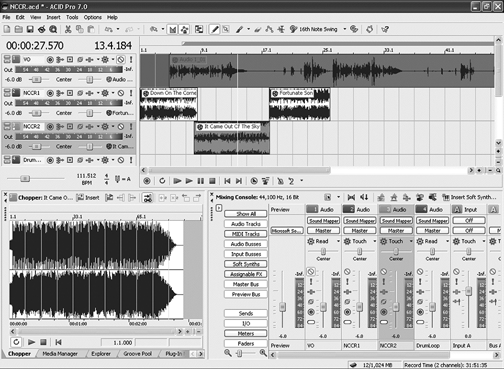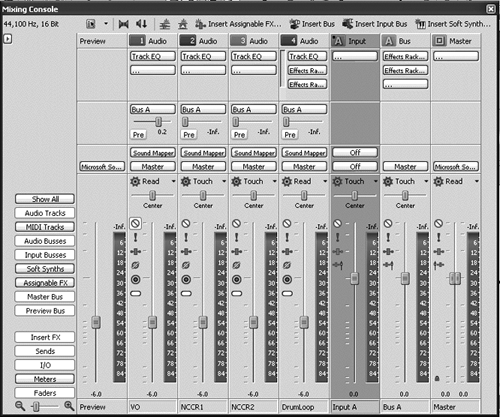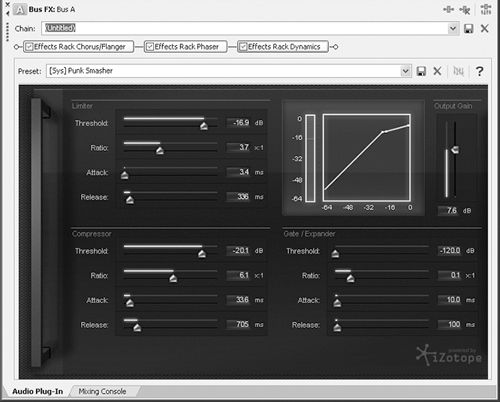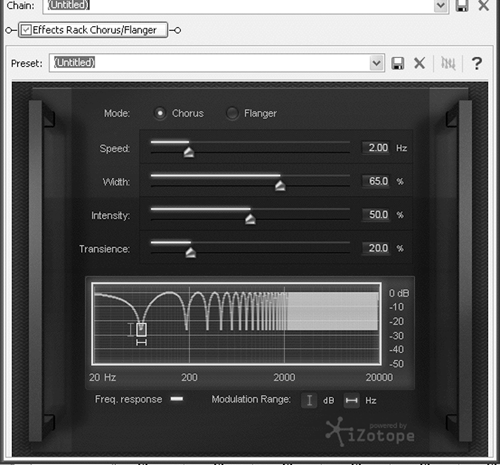by Steve Cunningham
Having recently checked in with two of our favorite Sony products, Vegas 8 and SoundForge 9, I thought it time that we check in on Sony’s Acid product, which has recently arrived at version 7. A percent-off email that showed up on Black Friday provided me with further encouragement to upgrade. Moreover, we haven’t checked in with Acid since version 3 way back in 2002, and the loop-based production tool has changed a great deal in six years.
For one, Acid has added full-blown audio recording and editing to its arsenal of looping tools. And like its sibling SoundForge and Vegas, Acid 7 now has a full-fledged mixing console interface. I’ve been a fan of Acid in the past for its ability to time-stretch and -shrink music files for concert promos, with few or no audio artifacts. Acid 7 does this job with even fewer artifacts than before thanks to its use of new algorithms from Germany-based Zplane Development.

SETTING UP
Like most Sony audio products, Acid 7 can be set up rather quickly. Its copy protection is serial-number based, so there’s no need to find another USB port for a dongle. In fact, the longest portion of the entire process for me was simply downloading the software, which includes several gigabytes of loops and a couple of sample-based soft synths.
Acid’s requirements are in line with most of today’s editors: Windows XP SP2 or Vista, a 1.8 GHz processor with 2 GHz or faster recommended,
1 GB of RAM with 2 GB or more recommended, 150 MB of hard disk for the program and another 8 GB of optional components including loops and software samplers, a Windows-capable sound card, a CDR drive for burning CDs and a DVD drive for reading the program disk. You can, as I did, opt to download all the software. Just be aware that the program is small enough, but downloading 4+ GB of content takes quite a while even on a fast connection.
WHAT’S NEW
It’s been so long since we’ve looked at Acid in these pages that the list of changes and improvements would take up more space than this writer is allotted per month. So we’ll just hit the highlights of earlier versions that are applicable to beat matching and production work in general, and focus on the new version.
The most significant improvement is in the user interface, where Sony have added a real Mixing Console window to Acid version 7, as they have done with Forge 9 and Vegas 8. I sincerely hope there was a second monitor for your rig under the Christmas tree, as you’ll need that, along with a dual-head video card. The new Mixing Console window does not replace the current Mixer window, but allows you to see the entire mixer in a single window, which is invaluable for setting up complex bussing schemes, and makes Acid a viable production tool that can take music promos from start to finish.
The new Mixing Console window is home to the same set of controls as the Mixer window shows, including buttons for Properties, Downmixing (from surround to stereo or stereo to mono), Dim Output, and Insert Audio Track/Assignable FX/Bus. In addition, a list down the left-hand side displays all available channels (based on your tracks) with a checkbox to show or hide any or all of them. The show/hide checkbox works on whatever tracks are currently selected, and it’s easy to see at a glance which tracks are not visible. One small quibble is the re-sizeable dividing line between this list and the rest of the Mixing Console display -- I tend to use succinct labels for tracks (which of course become the channel names in the Mixing Console), but the dividing line can’t be moved leftward past a certain point. In my case that point leaves the list about twice as wide as it actually needs to be, and wastes valuable screen real estate in the process. But this is a nit, and only serves as additional motivation for that second monitor, yes?
Between the track list and the Preview channel are two groups of vertical buttons that let you show or hide tracks or functions selectively, with the top button labeled Show All. The upper group lets you hide tracks by their type, while the lower buttons let you hide sections by function. Don’t want to see any buss tracks? Just press the busses button. Pressing the I/O button from the lower group will hide those buttons and extend the meters/faders to fit. You will note that some of the lower function show/hide buttons may not seem to work, depending upon your screen resolution.

BIG MIX, NEW PATHS
With the Mixing Console Window fully extended vertically and all Show buttons enabled, the mixer shows the aforementioned Properties, Downmixing, etc. buttons along the top, then the Insert FX group, then the Sends group, then the I/O, and finally the Faders with meters alongside. Moreover, the dividing lines between the Insert FX group and the Sends group, and between the Sends group and the I/O group are both moveable with the mouse. You can set up what you see and what you hide to suit your style of workflow and tastes. Very nice.
Additional coolness within the new mixer includes full track envelope automation that works in real time, and can be controlled with either a mouse or an external fader box. Automation envelopes are graphically editable with moveable breakpoints and curves. The automation itself works in Read, Write, Touch, and Latch modes, with the latter two kicking in when you grab a fader and kicking out either when you release the fader (Touch) or when you stop playback (Latch). All the while you can monitor your tracks with real-time track DSP effects, both while in record and in playback.
Also new are input busses, which allow you to record from external devices through effects processors thereby printing them wet, combine external sources with projects in real time, as well as process tracks through external effects. To help you see what’s happening during complex sessions, meters are now available on both audio tracks and busses. These are new meters that can be customized with regard to both position and scale. You can even label your ASIO input and output devices, so you’re not relying on the default names to figure out what is going where. Sweet.
Of course, Acid 7 retains all the functionality of previous releases, including an interface that is extremely easy to use, a Video window for working to picture, windows that can be torn off or docked, and the aforementioned automatic, real-time pitch-shifting and tempo- matching that is as good as it gets.

KILLER APP
For creating music promos and beat matching in general, Acid is still a killer app thanks to its adept implementation of time-stretch and -shrink audio files, and its ability to create seamless audio loops. These can be manipulated together or independently, making it easy, for example, to alter the tempo of a pop song slightly when matching it to other songs in a promo, or even to pitch-shift a VO read to get a specific effect. Audio loops can be stored in an ‘Acidized’ format which contains information about the original recording tempo, length (in beats) and root-note pitch. Like several other audio editors, Acid uses a resynthesis technique for time-stretching, which has markedly improved since Sony licensed Zplane’s elastique Pro software component. Zplane makes three versions of their algorithms available for licensing, and the Pro version in Acid 7 generates the highest quality results, according to the company. I was definitely able to apply more stretch before I heard glitches, in some cases well over 20%. The results are generally excellent, and although with any pitch-shifting or tempo-stretching the process only works within certain limits before audio artifacts appear, the new algorithms in Acid 7 allow a much more radical degree of stretch or shrink without artifacts than before.
The other key component of the Acid experience has always been the straightforward organization and ease of use of the interface. This makes the mixing and matching of loops so simple that, with the right combination of loops and music that’s somewhat close in tempo, even part-timers can use it to create very impressive results. The ability to preview Acidized loops in real time means that auditioning a new loop simply involves clicking on a file as you browse your loop collection in the Explorer window -- you’ll automatically hear it with its tempo and pitch mapped to those of the project.
The Media Manager goes a long way towards making those loops more accessible. It’s included with Acid 7 (and with Forge 9 and Vegas 8), but it is a separate install. Don’t ignore it -- it definitely speeds workflow. The Media Manager automatically scans your hard drives and finds audio bits, or you can manually add items. Once they’re in the Media Library, you can tag ‘em and bag ‘em, organizing them into folders with useful names (now there’s a concept!). As you do, the Media Manager builds a searchable database that works across all three Sony products, so if you’re a Vegas user your library may already be done. Of course if you buy any loops from Sony, they come to you pre-tagged for your dining pleasure.

EXTRAS
Sony bundles a whole lot of goodies with Acid 7. Unfortunately most of them are aimed at musicians -- there’s a Garritan sample playback plug, a guitar sample player from Native Instruments, and even a cut-down version of Submersible’s Drum Core plug-in. Fun if you’re into that, I suppose. But they do include four effects from iZotope (one of my favorite propeller-head DSP wizard companies) that are excellent.
I’m a big fan of authentic-sounding analog effects plugs, particularly Phasers and Flangers. The Flanger and Phaser included with Acid 7 are simply outstanding. The Flanger will also create a nice chorus effect, and can generate comb filters that are either gentle and sparse or deep and dense. The Phaser can be set to one stage for a gentle effect, or six stages for a deep swoosh, or anywhere in between. The Phase Difference slider lets you dial in the affected frequencies, and an EQ lets you tame the effect.
The Analog Delay plug has settings to emulate tape, or tape through tubes, or good old analog bucket brigade delay. There’s even a Trash setting to give you a little analog grit. The Dynamics plug has individual settings for compression, limiting, and expansion/gating, giving you the ability to set a multi-segment dynamics curve to handle just about anything. It sounds excellent, with no coloration... just lots of squash.

HELP PLEASE
The documentation included with Acid 7 is, frankly, a bit sparse. Whether you buy the download and get it as a PDF, or buy the boxed set and get a soft cover manual, it covers only the basics. However, Acid 7 comes with built-in interactive tutorials which are a help. I found that there’s a certain amount of trial and error involved in getting two dissimilar songs to play nicely together in a promo using Acid, and once I’d gone through the tutorials I felt mostly on my own.
Fortunately the learning curve gets flatter as I spent more time with the program. The fact that it’s organized much like Forge and Vegas certainly makes it easier, but if you’re going to create an entire music promo in Acid for the first time, you may want to take a dry run at it in private.
But once I established a workflow I was good to go, and it’s fun. The program’s ability to stretch and shrink music beyond recognition, almost without artifacts, is amazing. Now that it will record and edit audio just like Vegas, Acid has become a serious tool for any project that requires beat matching as part of the production process.
Acid has become a mature product for pros. If you’ve got an old copy of Acid Pro in any version tucked away on your hard drive, you should seriously consider the upgrade. It’s well worth it. Steve sez check it out.
Acid Pro 7 carries a US suggested retail price of $299.95 (download) or $314.95 (boxed). Upgrades from previous versions start at $134.95. A demo version is available, as is more information at www.sonycreativesoftware.com.
♦

